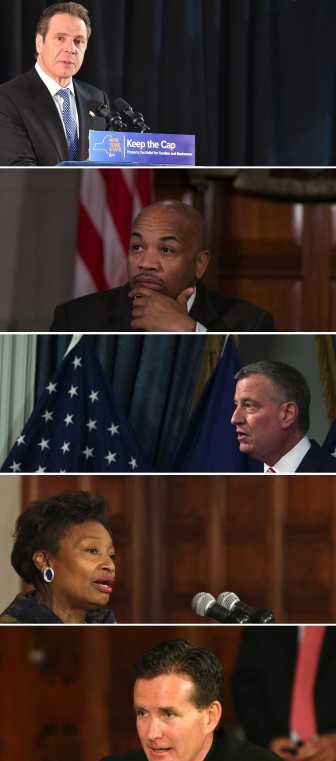
Demetrius Freeman and the Office of the Governor
Some of the dramatis personae in the housing policy debate: Gov. Cuomo. Speaker Heastie, Mayor de Blasio, Senate Minority Leader Stewart-Cousins and Senate Majority Leader Flanagan
The housing-policy perfect storm that was visible on the radar months ago has arrived right on time: 10 days from the deadline for the state to renew rent regulations and the 421-a tax abatement, there’s no hint of an agreement by the players in Albany or among the most powerful Democrats in the state.
There are a lot of proposals and counter-proposals circulating. Here’s a rundown of the leading issues and proposals around rent regulations. We’ll update the scene around 421-a on Monday:
The regulations, which were last tweaked in 2011, cover the roughly 1 million apartments that are part of the city’s rent stabilization system. The rent on those apartments can only rise as much as the Rent Guideline Board permits, and stabilized tenants also get protections from harassment under the regs.
Tenant advocates say the regulations are a bulwark for affordability in New York. While some stabilized apartments could not be considered affordable to anyone of lower-income or moderate means, most of the units covered by the law do provide affordable housing. Changes to the regulatory system over the years (especially vacancy decontrol) have worked to decrease the size of the stabilized stock.
Landlords argue that the remaining restrictions on rent prevent them from generating enough revenue to adequately maintain their buildings and discourage property owners from entering the marketplace.
Landlord groups would like to see the regulations scrapped, but that is unlikely. Tenant advocates argue that the status quo favors landlords because, under a provision called vacancy decontrol, apartments leave the stabilization system when they reach a certain rent—right now the threshold is $2,500 per month. Every apartment in the system creeps toward that threshold every time the RGB raises rents.
What’s more, other features of the system—a vacancy bonus that permits landlords to hike the rent 20 percent when an apartment changes hands, major capital improvements (MCIs) and individual apartment improvements (IAIs) that grant landlords extra rent increases for work on their properties, and preferential rents that allow a landlord to react to market conditions by suddenly imposing rent hikes that were deferred in earlier years—mean landlords can move toward the threshold in leaps and bounds. Advocates for tenants say those tools give perverse incentives to landlords to drive tenants out and inflate repair costs. Landlords say the measures are necessary to keep buildings capitalized.
Mayor de Blasio: The mayor has called for eliminating high-rent vacancy decontrol (there is also a high-income vacancy decontrol mechanism but it’s not a significant issue) and getting rid of the vacancy bonus. He also proposes permitting rent increases for MCIs or IAIs only for the time needed to pay off the repair costs; right now, they are permanent.
Assembly Democrats: The bill introduced by Harlem Assemblyman Keith Wright ends vacancy decontrol and calls for re-regulating most apartments that left the stabilization system in earlier years. It reduces but doesn’t end the vacancy bonus. It reforms the MCI and IAI programs as de Blasio proposes. It also regulates how landlords may withdraw preferential rents. It would extend the regulations for four years, a timeline some tenant advocates dislike because the spring of 2019 falls immediately after statewide elections, and therefore at a time when legislators and the governor are least vulnerable to the kind of pressure tenant groups can bring.
Senate Democrats: The proposal articulated by Sen. Andrea Stewart-Cousins would end vacancy decontrol, re-regulate vacancy-decontrolled units, and reform the MCI and IAI programs like the Assembly and de Blasio propose. In a key difference from their Assembly counterparts, the Senate Dems would eliminate—not just reduce—the vacancy bonus. They also seek a renewal for only two years.
Gov. Cuomo: The governor hasn’t provided very much detail on what he wants to see, but has said he supports continuing the regulations and adjusting—but not ending—vacancy decontrol, pushing for a modest increase in the decontrol threshold from $2,500 to $2,700. He made his most detailed statements to date in a radio interview summarized by Capital NY:
Cuomo did not rule out a straight extension of rent regulations or 421-a, but called a one-year continuation as “the least acceptable option.” He said he would like to see rent control strengthened, and proposed raising the rent threshold above which units fall onto the open market to $2,700 per month, from $2,500. Cuomo also said that the law should be changed so major capital improvements are not able to be counted toward rent increases as much as they currently are.
As expected, Cuomo came out against repealing vacancy decontrol—the process through which units fall out of regulation, to the dismay of tenant advocates—but declared himself open to tweaks.
“We actually have to make changes to the law that tightens the law so we lose fewer units … At the same time, there are people who are in rent controlled units who don’t belong in there,” Cuomo said. “Vacancy de-control, I think, can be improved. I don’t think you ever get to repeal of it, but we’re talking about modifications that can make the law a better law.”









2 thoughts on “10 Days and Ticking: Your Rent Regulations Cheat Sheet”
Pingback: Cuomo’s Power Tested on Rent Regulations | NYC Informer
Pingback: Tenants Rally in Albany for tougher Rent regulation Laws | brooklyn laundry social club